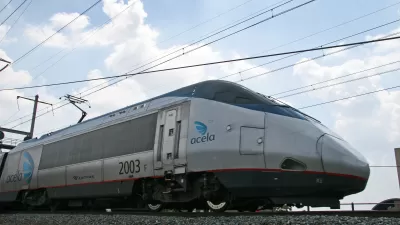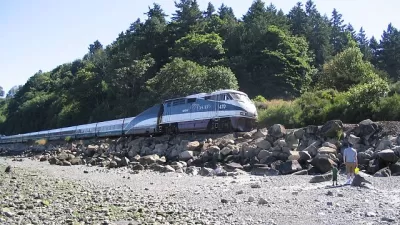A new report from the Brookings Institution delves into the ridership and financial winners (and losers) for America's largest intercity rail operator. Last year, Amtrak made money on its 26 routes shorter than 400 miles.
Not only has Amtrak reached record levels of ridership, it's also the nation’s fastest growing mode of transportation says a new report out today from the Brookings Institution. By looking closely at how each of the federally subsidized carrier's more than 40 routes perform (by riders and by net revenue), the study's authors have found that it is essentially two systems in one, writes Brad Plumer. "One system is quite successful, the other isn’t."
"First," he explains, "there are Amtrak’s shorter passenger routes that run less than 400 miles and tend to connect major cities. Think of the Acela Express in the Northeast, or the Pacific Surfliner between San Diego and Los Angeles. These 26 routes carry four-fifths of Amtrak’s passengers, or 25.8 million riders per year. And they’re growing rapidly. Taken as a whole, these shorter routes are profitable to operate — mainly because the two big routes in the Northeast Corridor earn enough to cover losses elsewhere."
"Then there are Amtrak’s 15 long-haul routes over 750 miles. Many of these were originally put in place mainly to placate members of Congress all over the country, and they span dozens of states. This includes the California Zephyr route, which runs from Chicago to California and gets just 376,000 riders a year. All told, these routes lost $597.3 million in 2012."
With Congress regularly threatening to slash Amtrak's $1.4 billion in federal subsidies, what can be done?
"The Brookings report argues that Congress should arrange a deal with the states for these 15 longer money-losing Amtrak routes," says Plumer. "If a route is losing money, then the states that are in its path should negotiate how best to provide financial support and fill the hole. (Under this plan, they’d be allowed to use federal transportation funds.) If the states can’t or won’t chip in, then the routes get pared back."
"All told, a deal with the states could trim the need for subsidies by some $800 million per year — at that point, Congress would no longer need to cover Amtrak’s operating losses. The main thing the federal government would need to pay for is upgrades to the tracks that Amtrak currently owns in the Northeast Corridor."
FULL STORY: Amtrak loses a ton of money each year. It doesn’t have to.

Alabama: Trump Terminates Settlements for Black Communities Harmed By Raw Sewage
Trump deemed the landmark civil rights agreement “illegal DEI and environmental justice policy.”

Study: Maui’s Plan to Convert Vacation Rentals to Long-Term Housing Could Cause Nearly $1 Billion Economic Loss
The plan would reduce visitor accommodation by 25% resulting in 1,900 jobs lost.

Planetizen Federal Action Tracker
A weekly monitor of how Trump’s orders and actions are impacting planners and planning in America.

Waymo Gets Permission to Map SF’s Market Street
If allowed to operate on the traffic-restricted street, Waymo’s autonomous taxis would have a leg up over ride-hailing competitors — and counter the city’s efforts to grow bike and pedestrian on the thoroughfare.

Parklet Symposium Highlights the Success of Shared Spaces
Parklets got a boost during the Covid-19 pandemic, when the concept was translated to outdoor dining programs that offered restaurants a lifeline during the shutdown.

Federal Homelessness Agency Places Entire Staff on Leave
The U.S. Interagency Council on Homelessness is the only federal agency dedicated to preventing and ending homelessness.
Urban Design for Planners 1: Software Tools
This six-course series explores essential urban design concepts using open source software and equips planners with the tools they need to participate fully in the urban design process.
Planning for Universal Design
Learn the tools for implementing Universal Design in planning regulations.
Caltrans
Smith Gee Studio
Institute for Housing and Urban Development Studies (IHS)
City of Grandview
Harvard GSD Executive Education
Toledo-Lucas County Plan Commissions
Salt Lake City
NYU Wagner Graduate School of Public Service





























